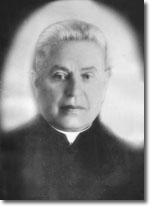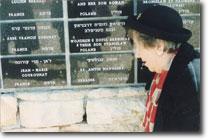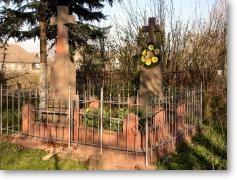|
Anton Navolskyy (1894-1965)
 |
|
Anton Navolskyy arrived in Tluste around
1930 to succeed Teodozij Kurpiak as parish priest. Over
the next four decades, he distinguished himself in the
manner in which he served the entire community.
One of his first tasks was to realise the completion
of the Greek
Catholic church, whose construction had begun in
1912, but languished for two decades because of insufficient
funding. He managed to raise the necessary funds, and
the exterior work was completed under his guidance in
1939. |
During the Nazi occupation of Tluste, between June 1941 and
March 1944, Navolskyy also distinguished himself in a way
that no one would have anticipated. The first two years of
that period were marked by relentless persecution and killing
of Jews in Tluste, culminating in the virtual extermination
of the remaining population in mid-1943. While these atrocities
were being committed all around him, Navolskyy sheltered Jews,
at great risk to himself, hiding them in a shed and arranging
for food to be brought to them.
| It is not known how many Jews Navolskky
harboured during the war, saving them from near certain
death; but his efforts were formally acknowledged by an
inscription on a memorial wall at Yad Vashem in Israel.
His courageous acts only came to light many years later,
when people felt less insecure discussing the events of
that period. Most townspeople were unaware of these acts
of human decency that were occurring at the time. |
|
 |
In the mid-1940s, under the new Soviet regime, Navolskyy
faced a challenge of a completely different nature. According
to the resolutions of party bodies in Lviv on 8-10 March 1946,
the decisions of the so-called Brest Union were cancelled
and the Greek Catholic Church became subordinate to the Russian
Orthodox Church. The Greek Catholic church of Tovste continued
to function secretly through underground activities. Anton
Navolskyy was allowed to conduct mass for some time, but in
the 1950s he was relieved of his duties.
 |
|
When Anton Navolskyy died in 1965, his body
lay in state in the Greek Catholic church in Tovste, and
people flocked to the town from surrounding villages to
mourn his passing. He is buried in the old Catholic cemetery
in a well-maintained plot, next to the grave of his mother. |
* * * *
Much more could be written about the life of Anton Navolskyy.
This short article barely scratches the surface of his life’s
work and selfless service on behalf of the community of Tluste/Tovste.
Fortunately, Bogumila Berdychowska, Head of the Department
for Cultural Development and International Cooperation, of
Poland’s National Cultural Center, has written a more
extensive article that was published in the newspaper Tygodnik
Powszechny on 25 April 2004, entitled: “Requiem
dla Antina Nawolskiego”. In due course, it is hoped
that an English translation of the article can be arranged,
so that more details of the life of this special man can be
communicated to a wider audience.
Source:
Pawlyk, J. History of Tovste. Chortkiv, 2000. and
pers. comm. 
|

